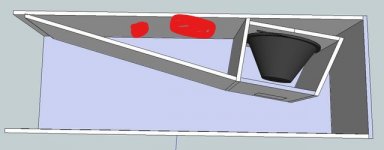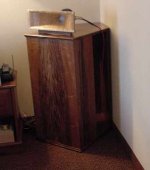It would take time to draw, but it can be done longitudinally or transversely. Eg imagine looking down a round horn and it is quartered. You can lean a triangular board up against a wall and you have this kind of shape. The point is that you remain in control of the expansion on one side. It can be done across ways as well. Just envision the space you have which won't interfere with the mids and highs and fit your horn into it using as much of the room surfaces as you can, but keep the horn area expanding. Then consider the nature of the bends.
By the way the corner waveguide approach is neat, and should have minimal resonance due to the tidy nature of the 'baffle'. It will have high sensitivity due to the loading and minimal nearby reflections regarding specific walls. On the other hand it doesn't horn load, if that is important to you and it will activate whole room modes. The modes are no problem if you use multiple subs, but then it kind of defeats the whole horn thing. It's fine for the very lowest frequencies to put a sub in the corner.
By the way the corner waveguide approach is neat, and should have minimal resonance due to the tidy nature of the 'baffle'. It will have high sensitivity due to the loading and minimal nearby reflections regarding specific walls. On the other hand it doesn't horn load, if that is important to you and it will activate whole room modes. The modes are no problem if you use multiple subs, but then it kind of defeats the whole horn thing. It's fine for the very lowest frequencies to put a sub in the corner.
Ah alright, found an old patent showing something like you describe, but didn't bookmark it and now can't find it  Found an image from another forum and added some red "More ways" to illustrate your thought?
Found an image from another forum and added some red "More ways" to illustrate your thought?
Not sure if there is any need for loading in my situation. Current BR box in the corner is loud enough. I'm wondering if the acoustic low pass of a horn would make the sound better and if there was help for the room modes as well. Multiple subs is the plan, but have none yet. Maybe it is the sub time first before even considering this kind of huge build.
Room dimensions are all close multiple to the height, unfortunately, so corners are involved with the strongest 70-80Hz mode I'm having which seems to be due to all kinds of modes stacking up and corners are involved in all of them of course. Thought that maybe with full height tower of bass there was a possibility to try to tune this a bit, or a full room height mouth? Direct radiating woofer at mid height should work I think. Could do direct radiating with woofers on all the front wall corners. Alright this goes off topic soon as multi-way discussion
Direct radiating woofer at mid height should work I think. Could do direct radiating with woofers on all the front wall corners. Alright this goes off topic soon as multi-way discussion  Thanks all helping me forward with the quest!
Thanks all helping me forward with the quest!
Not sure if there is any need for loading in my situation. Current BR box in the corner is loud enough. I'm wondering if the acoustic low pass of a horn would make the sound better and if there was help for the room modes as well. Multiple subs is the plan, but have none yet. Maybe it is the sub time first before even considering this kind of huge build.
Room dimensions are all close multiple to the height, unfortunately, so corners are involved with the strongest 70-80Hz mode I'm having which seems to be due to all kinds of modes stacking up and corners are involved in all of them of course. Thought that maybe with full height tower of bass there was a possibility to try to tune this a bit, or a full room height mouth?
Attachments
Last edited:
I'm trying to find out if a small footprint (front loaded) bass horn is possible by utilizing the whole room height.
Again, a typical room corner makes a 180 deg vertical and 90 deg horizontal parabolic horn. This is your low frequency part of the FLH, ergo a small footprint FLH in comparison is only a high frequency one due to its short axial length. In short, a somewhat crude co-ax horn system.
To do what you apparently want FLH wise requires you to do as Paul Klipsch did in the 1940's and fold up the rest of the FLH to fit in the desired footprint and with a flare factor [expo/whatever] that blends whatever flare frequency you've chosen [30 Hz/whatever] to the room's parabolic expansion specs.
Acoustically, the driver is however far behind the wall corner, so before digital time delay, no way to align it with the mids/HF horns, ergo this was its practical design limit based on human hearing acuity.
GM
There isn't really a horn that terminates correctly into a whole corner, except for an eighth space waveguide (although it may be used to benefit a much foreshortened horn).
IIRC the Pi Speakers corner horn is just a sealed box JBL 2225H? [BP4] shaped such that it loads at the corner's bottom apex to make a 90 x 90 initially. The mono setup I auditioned had a Japan? spec Fostex FE108EZ; don't remember the XO, but thinking it was just a PIO cap.
Regardless, a very impressive symphonic performance and a reminder just how overall superior a mono system can be Vs multi-channel.
GM
Not really, just apparently overwhelmed with way too much 'technobabble' to 'see the forest for the trees', i.e. take your existing woofer and tilt/space the driver to be on axis in both planes with the walls/floor apex [gapped to 'taste'] to get a basic version of the Pi Speaker corner horn [BP4 = compression horn driver alignment]; you'll come even closer if you add adjustable baffle 'wings' to extend/dial in its 'HF' horn loading.
Now really, is this too tough to tackle? ;)
GM
Now really, is this too tough to tackle? ;)
GM
Sorry tmuikku, I just wanted to say what was and wasn't on the cards.
I agree GM, there are many ways to look at it and make use of that space. My response was about using the corner until the other side/end/ceiling which had been asked at the time. Wayne seems to be using a quarter, which is then halved. Is that the same as an eighth? At those wavelengths even the bifurcation isn't too critical. Wayne does have some fairly open expansion beyond his horn though, along with plenty of support.
I agree GM, there are many ways to look at it and make use of that space. My response was about using the corner until the other side/end/ceiling which had been asked at the time. Wayne seems to be using a quarter, which is then halved. Is that the same as an eighth? At those wavelengths even the bifurcation isn't too critical. Wayne does have some fairly open expansion beyond his horn though, along with plenty of support.
Attachments
...there are many ways to look at it ...was about using the corner...Is that the same as an eighth?
Indeed! The U.S. patent office is awash in myriad variants, so imagine the others around the world also. [tmuikku, take note, there's some really simple ones for true woofer apps, i.e. < 2 octave use]
Understood, just that I took what I thought was the acoustic goal in a small footprint and posted the best overall/decades long proven solution, so not meant as any correction/whatever, just adding 'coals to the fire', so to speak as I'm known to do. ;)
Correct.
GM
- Status
- This old topic is closed. If you want to reopen this topic, contact a moderator using the "Report Post" button.
- Home
- Loudspeakers
- Full Range
- floor to ceiling horn?

